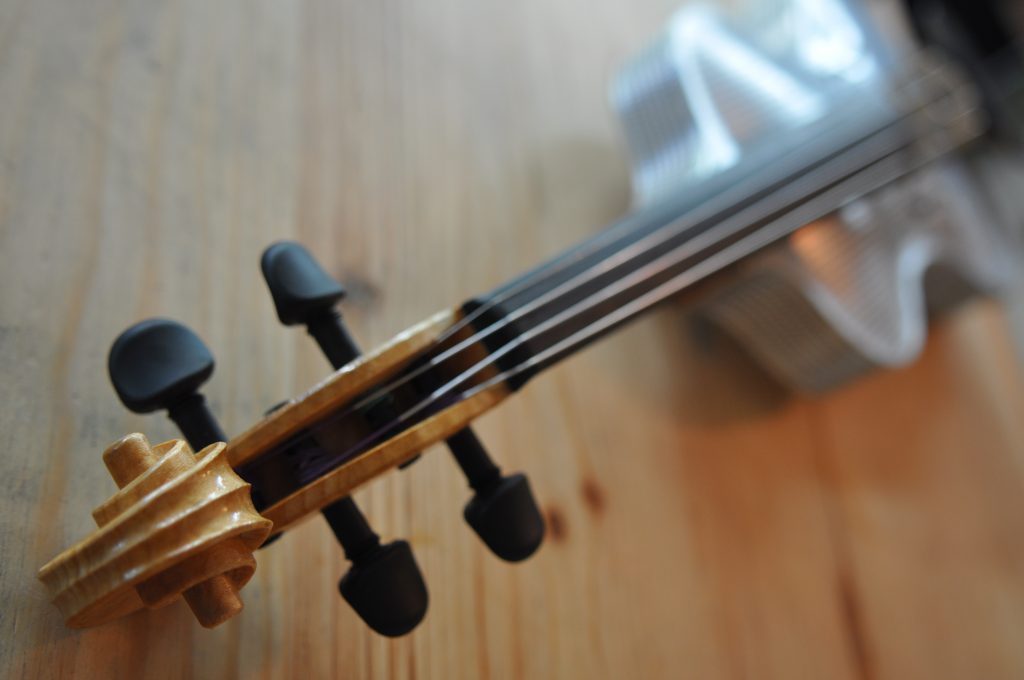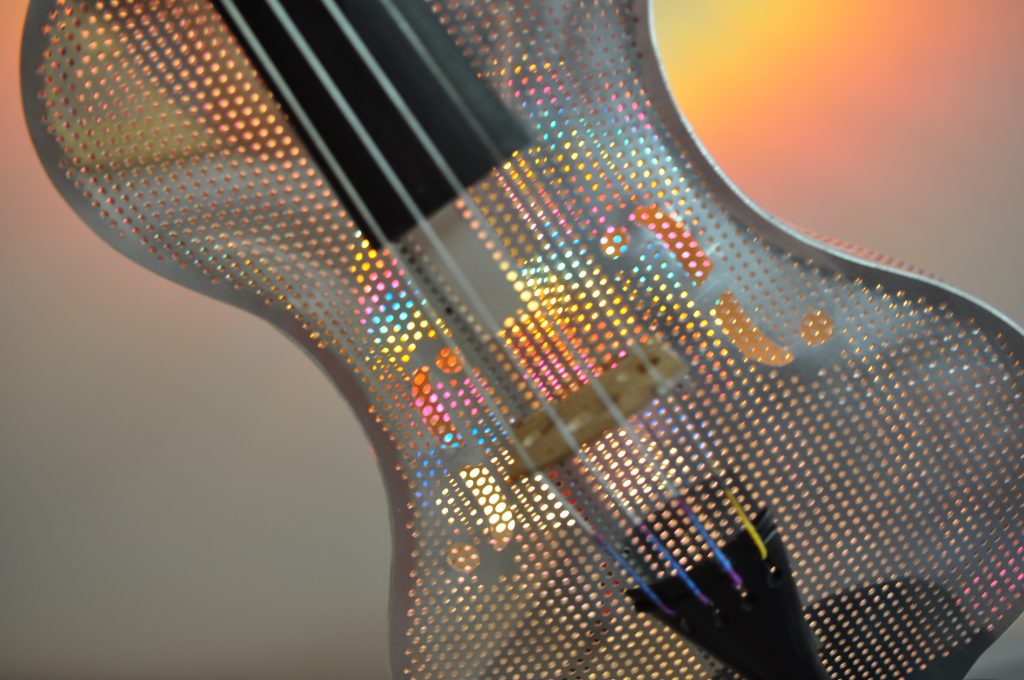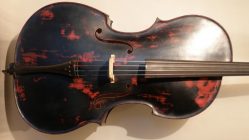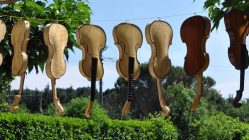
What is the Electrolin electric violin?
The Electrolin offers the sound and playing experience of a classical violin, with almost limitless possibilities for amplification and effects of an electric violin. It has a unique appearance, great comfort, and is made in France by its creator.
But the Electrolin is more than that: it’s YOUR electric violin, with numerous options for customization and adjustments (both in terms of lutherie and electronics) to get the sound you’re looking for.
Unplugged, the Electrolin is also an excellent mute study violin, offering better sound, response, and playing experience than a violin with a practice mute (lead), or an electric violin.
How is this possible?
To create the Electrolin, we abandoned the concept of a solid-body violin (meaning without a soundbox, like almost all other electric violins on the market), which has struggled for the past forty years to convince the vast majority of music lovers, let alone violinists, in terms of sound or playing experience. There’s nothing to be done: the “naked” vibration of a bowed string produces an artificial and unpleasant sound, and a full and inert body (a beam, essentially) cannot communicate the same sensations to the violinist as a soundbox can. Various electronic sound corrections in solid-body instruments – integrated from a certain range – can at best limit the damage.
Therefore, we had to give back the electric violin its soundbox because it’s the soundbox that, through a “selective sorting” among the harmonic spectrum of the bowed string, produces the sound of the violin that we know and love. But, a vibrating soundbox means problems of feedback at high sound volumes, especially when certain effects are added, which can render the instrument unusable.
No?
Well, no. The problem is not that the chamber vibrates, but that it resonates. The Electrolin offers an elegant and ingenious solution to separate the vibrations and resonance.
But how?
The key is the holes. Without getting into overly technical explanations (although you can ask us, we know everything down to the formulas!), a comparison with the good old pasta strainer is appropriate, visually and conceptually. Like water, air is a fluid, and just as water flows through the holes in the strainer, sound waves conveyed by air pass mostly through the Electrolin. The real source of feedback is not the sound emitted by the resonant chamber but the same sound returning to the chamber from the speakers, causing over-resonance and creating the feedback loop. The resonant chamber-speaker system gets stuck on certain well-known frequencies, causing the feedback (the diameters and spacing of the holes in Electrolin are calculated to avoid these frequencies).
In the case of Electrolin, sound waves, which are actually sequences of compressions and decompressions of air, pass through without causing damage, making Electrolin somewhat “invisible” to the returning sound.

So where does the sound come from?
Designed like a classical violin, with its arched top and back, proportions, f-holes, its sound transmission via bridge, sound-post and bass-bar, plus some compromises made with regard to the particular sound properties of aluminum, the Electrolin’s body vibrates in a way very similar to that of a classical violin. These vibrations are captured at three “hot spots”, on the Electrolin’s belly and back, by pick-ups using a piezo-electric polymer, PVDF, and transformed into an electrical signal, rendered by the speakers as a real violin sound – warm, lively, profound and nuanced.
Being able to genuinely interact with his instrument and bow, the musician can draw the whole palette of sound and modulations from his Electrolin, and not just variations in loudness.
Long story short: Amplified straight, the Electrolin offers the same possibilities as a classical violin, with the notable difference that the sound comes from the speaker – at 110dB, if need be.
We believe that the Electrolin is the perfect replacement for an amplified classical or electro-acoustic violin if your aim is a straight, amplified violin sound.
And it gets even more interesting if you play with effects – from the slightest reverb, via saturation, doubled octaves, to electro sounds or barbaric distortions. All effects have only the basic sound of the instrument to work on. If this sound is poor, cold, artificial and skimpy, so will the effects be. On the other hand…
To get a nice fat, fleshy effect, full of flavor and nuance, the straight sound has to provide all this in the first place. To push the culinary comparison even further (we are French, after all 😉 ) You don’t make a Tournedos maître d’hôtel with beef from the supermarket at two Euros the kilo, and chemical sauce in tubes.
Plug in your Electrolin, you’ll quickly get the idea. But beware! It’s addictive!
Amp or mixing table ?
The Electrolin’s sound is already close to that of an acoustic instrument.
Most amps carry out corrections and alterations on the entering signal. So, whether you use an acoustic amp or an electric guitar amp, the Electrolin’s sound will inevitably be altered, where no alteration is necessary, or beneficial. The best sound we got out of the Electrolin was with monitors. These speakers are made for studio mixes and offer the most neutral sound possible. That’s all you’ll ever need with the Electrolin !
There are several portable monitors on the market offering more than enough power.
To get the best out of your Electrolin, get a little two-way mixing table and connect it to a monitor. The result will be better than with an expensive amp, and cheaper.
That being said, feel free to try out several different amps which will color the Electrolin in different ways. In any case, you won’t need to hump your amp everywhere to be sure of a decent sound with the Electrolin.
Recommendations for effects
All existing electric guitar effects are worth testing, plus bass effects if you are playing an Electroloncello.
If you are a newbie when it comes to effects, we strongly recommend a digital multi-effect, which is a cheap and satisfying way to try out a multitude of effects to find out what you really like and want.
Afterwards, consider buying separate effect pedals, analog or digital.
Different brands have different specificities:
Mooer build very small pedals for really affordable prices. They might give you a bit of noise, but they remain pretty interesting for effects you use only occasionally.
You’ll find very psychedelic effects with a little vintage feel to them at Electro Harmonix.
Boss is a well-known producer of multi-effects, loopers and standard pedals, like the Metal Zone.
At the high end, TC Electronics are reputed for their very neat and elaborate sounds.
Finally, do not hesitate to try out less well known or hand-crafted pedals, as you might find good surprises there.
To do so, we strongly recommend you to follow Facebook groups that deal in second hand pedals. These groups give you the opportunity to learn something about the pedals before buying them, and to resell them if ever they do not satisfy you. As a general rule, try to check out one or two Facebook videos about the pedal you consider buying.
With the Electrolin, some special rules apply:
Vintage wah-wahs for electric guitars like the Cry Baby or the Vox should not be used if you are plugged directly into a mixing table. Those pedals add a significant gain of about 18 dB to the signal (originally to saturate the guitar amp), and will thoroughly saturate a mixing table input. Moreover, violins or even viola have a higher treble range than guitars, and thus require wah-wahs reaching higher into the treble.
So we recommend you look out for a wah-wah with adjustable gain and / or volume, like the Morley, or other wah-wahs with a maximum of manual adjustments.
Finally, adding up wah-wah and distortion might lead to feedback in the treble, if you play it really loud. If you consider playing with this kind of effect, you should get a gate, for example the Boss NS-1. It is affordable and offers a wealth of possibilities to set it up.
This is the only configuration in which you might get feedback from your Electrolin. But in this configuration, you’ll also get feedback from solid-body electric violins, or from electric guitars.
In any case, distortion might generate so much noise that you should use a gate. Guitar players use them, and they are also recommended for use with solid-bodies.
Advantages of analog vs digital effects ?
Analog effects are reputed for offering better sound quality, but in the end it all comes down to taste and fashion. For sure, digital effects offer far more possibilities when it comes to pitches or octave doubling, or temporal effects like delay or reverb.
Physical and acoustical operation, the musician’s view-point (Aurélien, viola player emeritus)
The Electrolin was conceived from the desire to play an electric violin that could offer a sound that resembles as closely as possible that of a classical violin. This sound offers incomparable richness of timbre and sound color.
Talking about my personal experience, I’ve heard guitar players rage when they heard me playing my Zef viola (predecessor of the Electrolin), saying that playing with a bow, I had much larger sound possibilities than they had. It’s the bow which allows us to play so intricately with the sound parameters – if the instrument we are playing permits it!
Based on the general experience and dissatisfaction of solid-body players around us, we found that it was essential to pick up the sound from the body, and not just at the strings.
But fitting an instrument’s resonant body with contact transducers (piezo or other), makes it extremely susceptible to feedback.
So to stop the resonant body from triggering feedback, it had to be perforated with thousands of little holes, as close one to another as possible.
These perforations would render a wooden resonance body very fragile and would be too costly to pierce into some composite fiber material.
That’s why we chose aluminum – which comes with its own wealth of difficulties, which are dealt with by the preamp.
The pick-ups
The Electrolins’s pick-ups are piezo-electric polymers (PVDF, or PolyVinyliDene Fluoride), stuck to hot spots on the belly and back of the Electrolin.
BE CAREFUL NOT TO DAMAGE THEM.
DO NOT SCRATCH THEM WITH A HARD OBJECT.
DO NOT GET THEM INTO CONTACT WITH A SOLVENT LIKE ACETONE OR ALCOHOL WHEN YOU CLEAN YOUR ELECTROLIN.
If you clean your Electrolin with a soft, dry cloth (as a classical violin in fact), just wipe softly over the pick-ups, without pressure.








